ضمان تميز المنتج: مراقبة الجودة & معايير التصنيع للأزياء النشطة & اليوغا ارتداء المصادر؟
تؤدي عمليات مراقبة الجودة غير المتسقة إلى ملابس نشطة تُفقد الحبوب أو تفقد الشكل أو تفشل أثناء التدريبات. تكتشف العديد من الشركات عيوب التصنيع فقط بعد أن تصل المنتجات إلى العملاء ، وتدمر سمعة العلامة التجارية وزيادة العائدات.
يتطلب مراقبة الجودة الفعالة لـ ActiveWear مقاربة شاملة: اختبار المواد قبل الإنتاج ، والمراقبة داخل الخط أثناء التجميع ، واختبار الأداء الموحد ، وفحص المنتج النهائي باستخدام معايير AQL ، واختبار المتانة للمتانة للتحقق من الأداء بمرور الوقت.
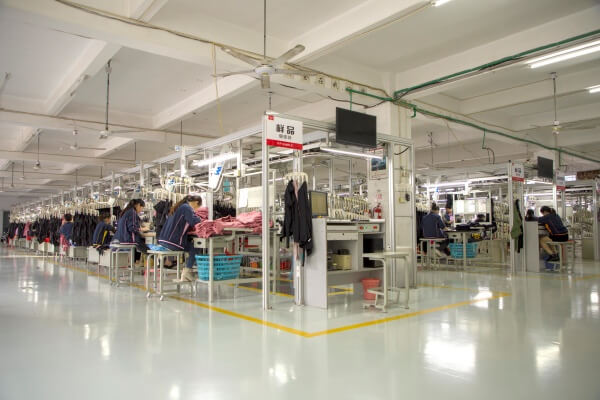
في امتلاكنا ، قمنا بتحسين عمليات مراقبة الجودة لدينا من خلال سنوات من الخبرة في التصنيع ، حيث وصلنا إلى أكثر من 30 مليون دولار في المبيعات السنوية التي تخدم أكثر من 3000 متجر. لقد رأيت بشكل مباشر كيف يمكن لبروتوكولات مراقبة الجودة المناسبة أن تحدث فرقًا بين المنتجات التي تفسد العملاء وتلك التي تضر بسمعة العلامة التجارية.
ما الذي يجعل مراقبة الجودة فريدة من نوعها للملابس النشطة؟
عمليات QC للملابس القياسية ليست كافية للملابس النشطة. تتطلب الطبيعة الفنية لهذه المنتجات اختبارًا متخصصًا لا يجهز العديد من الشركات المصنعة لأداء.
يجب أن تتحقق مراقبة جودة الملابس النشطة من جودة البناء ووظائف الأداء. إلى جانب فحص الملابس القياسية ، فإنه يتطلب اختبارًا متخصصًا لاستعادة التمدد ، وقدرة رطوبة الرطوبة ، واللون أثناء التعرق ، والتعتيم تحت التمدد ، والمتانة من خلال الغسيل المتكرر والارتداء.
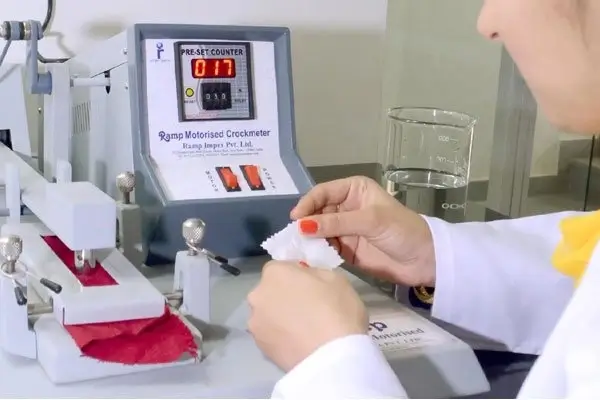
عندما بدأنا في تصنيع الملابس النشطة لأول مرة ، أدركنا بسرعة أن بروتوكولات QC للملابس القياسية لدينا لم تكن كافية. يجمع ActiveWear بين عناصر الأزياء والأداء الفني ، مما يتطلب اتباع نهج هجين لضمان الجودة.
الطبيعة المزدوجة للملابس النشطة QC
يجب أن يعالج مراقبة جودة الملابس النشطة جانبين متميزين:
1. جودة بناء الملابس
على غرار الملابس القياسية ، وهذا يشمل:
- سلامة التماس وجودة الغرز
- تحديد عيب النسيج
- مواصفات الحجم الامتثال
- تطبيق مرن وتقليم
- المظهر العام والانتهاء
2. وظائف الأداء
فريدة من نوعها في ActiveWear ، وهذا يشمل:
- اختبار التمدد والاسترداد
- التحقق من إدارة الرطوبة
- تقييم العتامة (خاصة بالنسبة لللباق)
- الصعود إلى العرق والاحتكاك
- المتانة من خلال الغسيل والارتداء
نقاط الفشل الحرجة
حددت تجربة التصنيع لدينا العديد من نقاط الفشل الشائعة التي تتطلب اهتمامًا خاصًا:
| نقطة فشل | تأثير | طريقة الكشف |
|---|---|---|
| فشل التماس أثناء التمدد | عوائد المنتج ، تلف العلامة التجارية | اختبار التمدد إلى نقطة الفشل |
| حبوب النسيج | ضعف المظهر ، قضايا الجودة المتصورة | اختبار التآكل مارتينديل |
| الشفافية أثناء الانحناء | الحرج العميل ، والعوائد | اختبار عتامة التمدد |
| نزيف اللون/التلاشي | عدم الرضا العميل | colorfastness للغسل والعرق والفرك |
للحصول على نظرة عامة شاملة على مواد وتكنولوجيا ActiveWear ، تفضل بزيارة دليلنا التفصيلي: Activewear & تقنية ارتداء اليوغا & المواد: دليل المشتري لأقمشة الأداء ، البناء & متانة.
كيف تبدو عملية مراقبة الجودة الشاملة؟
تنفذ العديد من الشركات عمليات مراقبة الجودة غير المكتملة التي تفوت المشكلات الحرجة. يغطي نظام مراقبة الجودة الفعال حقًا كل مرحلة من المواد الخام إلى المنتج النهائي.
تتضمن عملية شاملة لمراقبة الجودة لـ ActiveWear خمس مراحل رئيسية: اختبار المواد الخام (خصائص أداء النسيج) ، وموافقة ما قبل الإنتاج (تأكيد طرق البناء) ، وفحص في الخط (مشكلات الصيد أثناء التجميع) ، واختبار المنتج النهائي (مقاييس الأداء) ، واختبار الموثوقية (ضمان الزمن مع مرور الوقت).
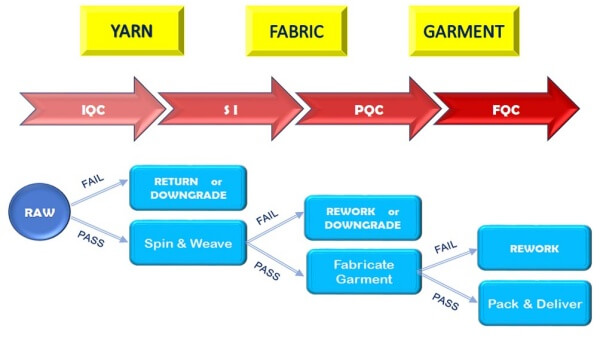
في وجود ، قمنا بتطوير عملية لمراقبة الجودة متعددة المراحل أثبتت فعاليتها على نطاق واسع. يضمن نهجنا جودة ثابتة حتى مع زيادة أحجام الإنتاج:
المرحلة 1: مراقبة جودة المواد الخام
قبل بدء الإنتاج ، تخضع جميع المواد للاختبارات الصارمة:
اختبار النسيج
- الخصائص الفيزيائية: الوزن ، سمك ، امتداد ، الانتعاش
- خصائص الأداء: رطوبة الرطوبة ، والتنفس ، والتجفيف السريع
- خصائص المظهر: تناسق اللون ، توحيد السطح
- اختبار السلامة: شهادة Oeko-Tex ، فحص المواد الضارة
التحقق من المكون
- الطبق: التمدد والانتعاش ، الصعود ، اتساق العرض
- المواضيع: قوة الشد ، الصعود ، التوافق مع النسيج
- حواف: المتانة ، قوة التعلق ، مقاومة التآكل (للمكونات المعدنية)
- تسميات/نقل الحرارة: قوة الالتصاق ، غسل المتانة ، الراحة ضد الجلد
المرحلة 2: موافقة ما قبل الإنتاج
قبل الإنتاج الضخم ، نتحقق من طرق البناء من خلال تقييم العينة:
- التحقق من طريقة البناء: تأكيد أنواع التماس الأمثل لكل منطقة
- التحقق من الصحة: التحقق من التحجيم عبر النطاق أثناء الحركة
- اختبار الأداء: التحقق من سمات الأداء الرئيسي على عينات ما قبل الإنتاج
- تقييم المظهر: تقييم المظهر العام ، مطابقة الألوان ، محاذاة الطباعة
المرحلة 3: مراقبة الجودة في الخط
أثناء الإنتاج ، يجري فريق مراقبة الجودة لدينا شيكات منتظمة:
- أول قطعة تفتيش: التحقق من القطع الأولى تلبي جميع المواصفات
- فاصل فاصل منتظم: فحص القطع طوال فترة الإنتاج
- فحص النقطة الحرجة: التركيز على المناطق عالية الخطورة (طبقات ، تطبيق مرن)
- التحقق من القياس: ضمان اتساق الحجم طوال الإنتاج
المرحلة 4: فحص المنتج النهائي
تخضع المنتجات المكتملة لتفتيش شامل قبل الشحن:
التفتيش القائم على AQL
نستخدم معايير مستوى الجودة المقبولة (AQL) لتحديد أحجام عينة التفتيش:
- عيوب حرجة: 0 ٪ مقبولة (قضايا السلامة ، فشل وظيفي كبير)
- عيوب رئيسية: 1.5-2.5 ٪ AQL (العيوب المرئية ، قضايا وظيفية بسيطة)
- عيوب بسيطة: 4.0 ٪ AQL (قضايا التجميل لا تؤثر على الوظيفة)
اختبار الأداء
الخضوع للعينات العشوائية تخضع للاختبار الوظيفي:
- التمدد والانتعاش: ضمان عودة النسيج إلى الشكل الأصلي
- اختبار الغضب: التحقق من عدم الانفصال أثناء التمدد
- إدارة الرطوبة: تأكيد قدرة الفتل
- قوة البناء: اختبار اللحامات تحت الضغط
المرحلة 5: اختبار الموثوقية
لضمان الأداء على المدى الطويل:
- اختبار دورة الغسيل: إخضاع عينات لدورات الغسيل المتعددة (عادة 20-30)
- الاحتفاظ بالأداء: قياس سمات المفتاح بعد الغسيل
- الاحتفاظ بالألوان: تقييم اللون بعد الغسيل المتكرر
- الاستقرار الأبعاد: التحقق من الانكماش أو التمدد
للحصول على رؤى حول بناء خط منتجات ActiveWear كاملة ، تفضل بزيارة دليلنا تنسيق مجموعتك: دليل B2B إلى ActiveWear & أنماط ارتداء اليوغا ، وظائف & خيارات المواد.
ما هي معايير الاختبار التي يجب تطبيقها على ActiveWear؟
بدون بروتوكولات اختبار موحدة ، من المستحيل تقييم جودة المنتج باستمرار. تفتقر العديد من الشركات إلى معايير الاختبار الواضحة ، مما يؤدي إلى تقييمات الجودة الذاتية.
يجب اختبار الملابس النشطة وفقًا للمعايير المعمول بها: التمدد والانتعاش باستخدام ASTM D2594 ، الصعود إلى AATCC 15 (العرق) و AATCC 61 (الغسيل) ، ومقاومة حبوب البهجة عبر ASTM D4970 ، وإدارة الرطوبة من خلال AATCC 195 ، واختبار التعتيم مع طرق نقل الضوء الموحدة.
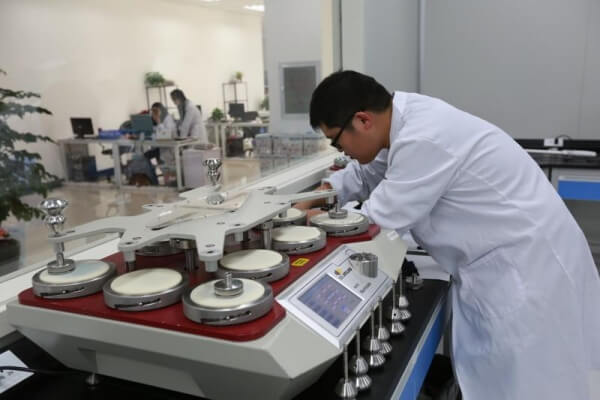
في الحصول على بروتوكولات الاختبار القياسية للصناعة لضمان تقييم جودة موضوعي. فيما يلي المعايير الرئيسية التي نستخدمها:
معايير اختبار الأداء
التمدد والانتعاش
- ASTM D2594: طريقة الاختبار القياسية لخصائص التمدد للأقمشة المحبوكة
- طريقة الاختبار: يتم تمديد النسيج إلى امتداد محدد ويتم قياس الاسترداد
- قياس: نسبة الانتعاش بعد الوقت المحدد
- المتطلبات النموذجية: الحد الأدنى 85 ٪ الانتعاش بعد 1 ساعة
colorfastness
-
AATCC 15: الصعود إلى العرق
-
طريقة الاختبار: النسيج المعرض لحل العرق الاصطناعي
-
قياس: تغيير اللون وتلطيخ على مقياس رمادي (1-5)
-
المتطلبات النموذجية: الحد الأدنى من تصنيف 4
-
AATCC 61: colorfastness للغسل
-
طريقة الاختبار: محاكاة الغسيل المتسارعة
-
قياس: تغيير اللون مصنفة على مقياس رمادي (1-5)
-
المتطلبات النموذجية: الحد الأدنى من تصنيف 4
مقاومة حبوب منع الحمل
- ASTM D4970: مقاومة التوهين وتغيير السطح
- طريقة الاختبار: Martindale أو طريقة تعثر عشوائية
- قياس: التصنيف البصري للحبوب (1-5)
- المتطلبات النموذجية: الحد الأدنى للتصنيف 4 بعد دورات محددة
معايير الأداء الوظيفية
إدارة الرطوبة
- AATCC 195: خصائص إدارة الرطوبة السائلة لأقمشة النسيج
- طريقة الاختبار: تدابير انتشار ونقل الرطوبة السائلة
- قياس: مؤشرات متعددة بما في ذلك وقت الترطيب ، انتشار السرعة
- المتطلبات النموذجية: يختلف عن طريق الاستخدام المقصود (معايير أعلى للأنشطة عالية الكثافة)
اختبار الغضب
- طريقة نقل الضوء
- طريقة الاختبار: قياس الضوء يمر عبر النسيج الممتد
- قياس: النسبة المئوية للضوء محظور
- المتطلبات النموذجية: الحد الأدنى 85-90 ٪ من التعتيم عند تمديده لارتداء اليوغا
معايير المتانة
-
ASTM D4966: مقاومة التآكل (طريقة مارينديل)
-
طريقة الاختبار: فرك النسيج ضد المتآكل القياسي
-
قياس: تغيير المظهر بعد دورات محددة
-
المتطلبات النموذجية: الحد الأدنى 10،000 دورة قبل التغيير الكبير
-
AATCC 135: التغييرات الأبعاد في الغسيل التلقائي
-
طريقة الاختبار: تدابير الانكماش بعد الغسيل
-
قياس: النسبة المئوية للتغير في الأبعاد
-
المتطلبات النموذجية: الحد الأقصى 3-5 ٪ التغيير
معايير اختبار السلامة
-
Oeko-Tex Standard 100: اختبار للمواد الضارة
-
طريقة الاختبار: تحليل كيميائي شامل
-
متطلبات: شهادة لفئة المنتج المناسبة
-
الامتثال CPSIA (للملابس النشطة للأطفال)
-
طريقة الاختبار: اختبار الرصاص والفثالات
-
متطلبات: تلبية معايير السلامة الفيدرالية
للحصول على معلومات مفصلة عن مواد الملابس النشطة وتقنيات البناء ، تفضل بزيارة دليلنا الشامل Activewear & تقنية ارتداء اليوغا & المواد: دليل المشتري لأقمشة الأداء ، البناء & متانة.
كيف تقوم بتقييم قدرات مراقبة الجودة للشركة المصنعة؟
تختار العديد من الشركات شركاء التصنيع على أساس الأسعار ، فقط لاكتشاف مشكلات الجودة بعد الإنتاج. من الضروري تقييم قدرات مراقبة الجودة بشكل صحيح قبل الشراكة.
عند تقييم إمكانات مراقبة الجودة للشركة المصنعة للأزياء النشطة ، قم بتقييم معدات الاختبار الخاصة بها (جهاز اختبار التمدد ، واختبار الصعود الملون ، وقياس العتامة) ، وموظفي مراقبة الجودة (فريق QC المخصص مع خبرة ActiveWear) ، والإجراءات الموثقة (بروتوكولات الاختبار الموحدة) ، وسجل التتبع (التجربة مع منتجات ومرجعات مماثلة من العملاء الحاليين).

في الحصول على الشركاء المحتملين على تقييم قدرات مراقبة الجودة لدينا بدقة قبل الالتزام بالإنتاج. بناءً على تجربتنا ، إليك العوامل الرئيسية التي يجب تقييمها عند تقييم الشركة المصنعة:
البنية التحتية الأساسية لمراقبة الجودة
معدات الاختبار
ابحث عن الشركات المصنعة مع:
- معدات اختبار أداء النسيج
- جهاز اختبار colorfastness
- أدوات قياس التمدد والاسترداد
- إعداد اختبار الغضب
- غسل مرافق الاختبار
قدرات المختبر
من الناحية المثالية ، يجب أن يكون لدى الشركات المصنعة:
- مختبر الاختبار الداخلي
- معايرة المعايير المعايرة
- مواد الاختبار القياسية
- أنظمة التوثيق
- أو علاقات ثابتة مع مختبرات اختبار الطرف الثالث
موظفي مراقبة الجودة
تقييم فريق مراقبة الجودة:
- موظفي مراقبة الجودة المخصصين (وليس فقط عمال الإنتاج)
- مدير مراقبة الجودة مع الخبرة ذات الصلة في ملابس الأداء
- برامج تدريب الموظفين
- المعرفة الفنية لمتطلبات الملابس النشطة
- نسبة موظفي مراقبة الجودة إلى حجم الإنتاج
الوثائق والإجراءات
الطلب والمراجعة:
- إجراءات مراقبة الجودة المكتوبة الخاصة بالملابس النشطة
- بروتوكولات الاختبار لسمات الأداء
- إرشادات تصنيف الخلل
- خطط أخذ العينات على أساس معايير AQL
- أنظمة حفظ السجلات
- إجراءات التتبع
سجل وتجربة حافلة
تقييم تاريخ الشركة المصنعة:
- تجربة مع منتجات أداء مماثلة
- مراجع العميل (وخاصة العلامات التجارية ActiveWear)
- عينة تناسق جودة
- أمثلة قرار المشكلة
- مبادرات التحسين المستمر
قائمة التحقق من التقييم في الموقع
عند زيارة الشركات المصنعة المحتملة ، راقب:
| منطقة لتقييم | ما الذي تبحث عنه |
|---|---|
| أرضية الإنتاج | النظافة والتنظيم والإضاءة والمعدات المتخصصة للملابس النشطة (آلات Flatlock و CoverStitch) |
| منطقة مراقبة الجودة | مساحة مخصصة ، إضاءة جيدة ، معدات الاختبار ، عينات مرجعية |
| نقاط التفتيش | نقاط تفتيش الجودة المرئية في جميع أنحاء الإنتاج ، وليس فقط التفتيش النهائي |
| تخزين المواد | نظام وضع العلامات للمواد نظيفة ، منظمة ، يسيطر عليها المناخ |
| توثيق | تعليمات العمل في المحطات وسجلات الجودة وأنظمة التتبع |
للحصول على إرشادات حول تطوير خط ActiveWear الخاص بك مع شركاء التصنيع الموثوق بهم ، استكشف موردنا على علامتك التجارية ، منتجك: الدليل الكامل للملصقات الخاصة (OEM/ODM) Activewear & اليوغا ارتداء التصنيع.
ما هي الشهادات المهمة لتصنيع ActiveWear؟
يمكن أن يكون التنقل في المشهد المعقد لشهادات النسيج ساحقًا. العديد من الشركات ليست على دراية بالشهادات ذات الصلة حقًا بالملابس النشطة.
تشمل الشهادات الرئيسية لـ ActiveWear Oeko-Tex Standard 100 (ضمان أن تكون المنسوجات خالية من المواد الضارة) ، و ISO 9001 (أنظمة إدارة الجودة) ، ومراجعات الامتثال الاجتماعي مثل BSCI أو Wrap (التصنيع الأخلاقي) ، وشهادات الاستدامة الاختيارية مثل Bluesign® (إنتاج صديق للبيئة) أو GRS (للمحتوى المعاد تدويره).
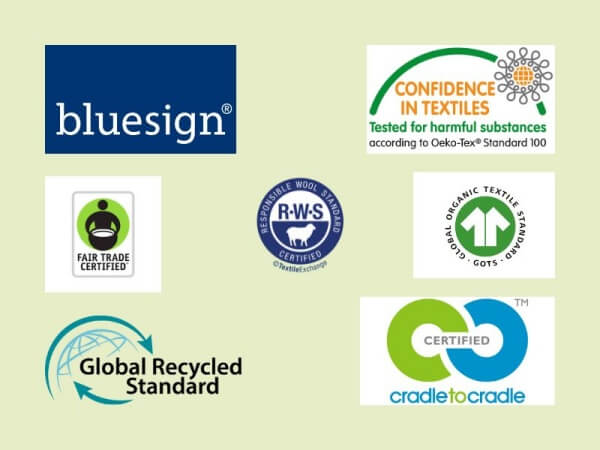
في الحصول على شهادات متعددة لضمان تلبية ملابسنا النشطة معايير دولية للسلامة والجودة والتصنيع الأخلاقي. إليك ما يجب أن تعرفه عن الشهادات ذات الصلة:
شهادات سلامة المنتج
Oeko-Tex Standard 100
- ما يشهد: تم اختبار المنسوجات للمواد الضارة
- أهمية: حاسمة للمنتجات ذات التلامس الجلدي المطول
- نطاق الاختبار: اختبارات المواد الخاضعة للتنظيم وغير المنظمة
- صحة: يتطلب التجديد السنوي واختبار منتظم
شهادة حماية الأشعة فوق البنفسجية (للملابس النشطة في الهواء الطلق)
- ما يشهد: قدرة النسيج على منع الأشعة فوق البنفسجية الضارة
- أهمية: ذات صلة لارتداء الأداء في الهواء الطلق
- طريقة الاختبار: تصنيف UPF (عامل حماية الأشعة فوق البنفسجية)
- المعيار المشترك: AS/NZS 4399 أو AATCC 183
شهادات إدارة الجودة
ISO 9001
- ما يشهد: أنظمة إدارة الجودة
- أهمية: يوضح النهج المنهجي للجودة
- متطلبات: الإجراءات الموثقة ، التدقيقات الداخلية ، التحسين المستمر
- فائدة: يقلل من خطر التناقضات الجودة
شهادات الامتثال الاجتماعي
مبادرة الامتثال الاجتماعي التجاري (BSCI)
- ما يشهد: ممارسات العمل الأخلاقية وظروف العمل
- أهمية: يتحقق من التصنيع الأخلاقي
- مناطق التدقيق: الأجور العادلة ، ساعات العمل ، الصحة والسلامة ، لا عمل للأطفال
- عملية: عمليات تدقيق مستقلة من الطرف الثالث
الإنتاج المعتمد العالمي المسؤول (WRAP)
- ما يشهد: القانون القانوني والإنساني والأخلاقي
- أهمية: برنامج الامتثال الاجتماعي المعترف به دوليا
- مجالات التركيز: ممارسات العمل ، وظروف مكان العمل ، والمسؤولية البيئية
- مستويات: مستويات شهادة مختلفة تستند إلى الامتثال
شهادات الاستدامة (اختيارية)
Bluesign®
- ما يشهد: إنتاج النسيج الصديق للبيئة
- أهمية: نهج شامل للتصنيع المستدام
- ركز: السلامة الكيميائية وكفاءة الموارد وسلامة المستهلك
- فائدة: نداء للعلامات التجارية الواعية بيئيا
المعيار العالمي المعاد تدويره (GRS)
- ما يشهد: المحتوى المعاد تدويره في المنتجات
- أهمية: ذات صلة بالملابس النشطة باستخدام البوليستر المعاد تدويره
- متطلبات: الحد الأدنى من المحتوى المعاد تدويره ، سلسلة التحقق من الحضانة
- فائدة: يدعم مطالبات الاستدامة
التحقق من الشهادة
عند تقييم شهادات الشركة المصنعة:
- طلب الشهادات الحالية (غير منتهية الصلاحية)
- تحقق من الشهادة من خلال موقع الهيئة المصدر
- تحقق من نطاق الشهادة (خاصة بالمنتجات ذات الصلة)
- اسأل عن إجراءات صيانة الشهادات
للرؤى السوقية وتفضيلات المستهلك فيما يتعلق بالمنتجات المعتمدة ، تفضل بزيارة تحليلنا لـ فهم الملابس النشطة & سوق ملابس اليوغا: الاتجاهات ، التركيبة السكانية & فرص المشترين B2B.
كيف تضمن جودة ثابتة على نطاق واسع؟
الحفاظ على تناسق الجودة أثناء تحجيم الإنتاج يمثل تحديًا شائعًا. يكافح العديد من الشركات المصنعة من أجل تقديم نفس مستوى الجودة عند الانتقال من الطلبات الصغيرة إلى عمليات الإنتاج الكبيرة.
يتطلب ضمان جودة ثابتة على نطاق واسع عمليات موحدة (الإجراءات الموثقة لجميع خطوات الإنتاج) ، والتدريب الشامل (ضمان فهم جميع العمال معايير الجودة) ، ومراقبة الجودة الإحصائية (باستخدام البيانات لتحديد التغيرات المعالجة) ، وأنظمة التحسين المستمر (مراجعة وتعزيز العمليات بناءً على النتائج).
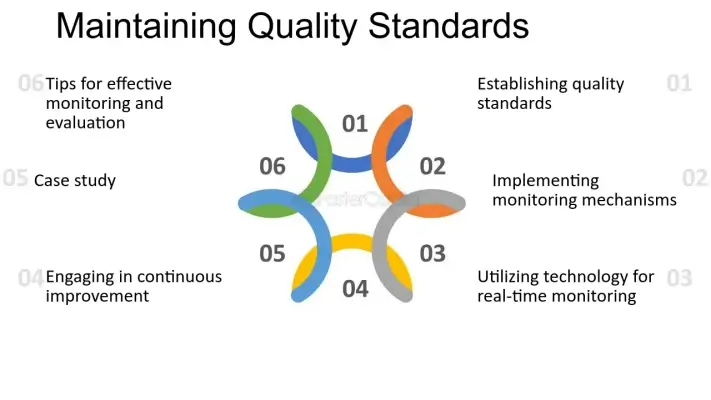
في وجودنا ، نجحنا في تحجيم إنتاج ActiveWear الخاص بنا إلى أكثر من 30 مليون دولار في المبيعات السنوية مع الحفاظ على جودة ثابتة. فيما يلي استراتيجياتنا الرئيسية لاتساق الجودة على نطاق واسع:
التوحيد والتوثيق
أساس الجودة المتسقة هو عمليات موحدة:
- تعليمات العمل التفصيلية: إجراءات خطوة بخطوة لكل عملية
- المعايير البصرية: أمثلة جسدية للجودة المقبولة وغير المقبولة
- مواصفات القياس: التسامح الدقيق لجميع الأبعاد
- معايير البناء: متطلبات محددة للطبقة والغرز والتقنيات
التدريب وتنمية المهارات
تؤثر مهارة العامل بشكل كبير على تناسق الجودة:
- التدريب الأولي الشامل: شامل على متن العمال الجدد
- شهادة المهارة: التحقق من الكفاءة قبل العمل المستقل
- تنمية المهارات المستمرة: تحديثات التدريب المنتظمة والتحسينات
- التدريب المتبادل: تطوير التنوع للحفاظ على المرونة
السيطرة على العملية الإحصائية
تتيح إدارة الجودة القائمة على البيانات الاتساق على نطاق واسع:
- قياسات في العملية: فحص منتظم للأبعاد الرئيسية
- تتبع العيوب: مراقبة أنواع وترددات مشكلات الجودة
- تحليل السبب الجذري: تحديد الأسباب الأساسية للمشاكل المتكررة
- تنفيذ الإجراء التصحيحي: نهج منهجي لحل القضايا
التكنولوجيا والأتمتة
الاستخدام الاستراتيجي للتكنولوجيا يعزز الاتساق:
- القطع الآلية: ضمان قطع النمط الدقيق
- خياطة التي يسيطر عليها الكمبيوتر: الحفاظ على جودة التماس متسقة
- فحص الجودة الرقمية: استخدام التكنولوجيا للكشف عن العيوب
- RFID تتبع: مراقبة المنتجات خلال الإنتاج
للحصول على معلومات حول التنقل في سلسلة التوريد واعتبارات اللوجستية ، تفضل بزيارة دليلنا على من المصنع إلى المستودع: فهم موقد ، أوقات الرصاص & الخدمات اللوجستية في Activewear & اليوغا ارتداء المصادر.
خاتمة
يعد تنفيذ مراقبة الجودة القوية والالتزام بمعايير التصنيع ضرورية لمصادر النشاط الناجح. من خلال فهم متطلبات الاختبار الفريدة ، وإنشاء عمليات مراقبة الجودة الشاملة ، والشراكة مع الشركات المصنعة المعتمدة بشكل صحيح ، يمكن للشركات أن تضمن أن منتجاتها تقدم أداءً ثابتًا وبناء ثقة المستهلك.
في الحصول على التزامنا بمراقبة الجودة ، مكّننا من توسيع نطاق إنتاج الملابس النشطة مع الحفاظ على التميز ، ومساعدة شركائنا على بناء علامات تجارية ناجحة في هذه الفئة التنافسية.
للحصول على نظرة عامة شاملة على فئة ActiveWear بأكملها ، بما في ذلك اتجاهات السوق وفرص العمل ، تفضل بزيارة دليل B2B النهائي للمصادر & بيع Activewear & ارتداء اليوغا.
الأسئلة المتداولة (الأسئلة الشائعة)
ما هي مشكلة الجودة الأكثر شيوعًا في تصنيع ActiveWear؟
تتمثل المشكلات الأكثر شيوعًا في الجودة في التواء (غموض السطح الذي يؤثر على المظهر) ، وفشل التماس أثناء التمدد (وخاصة في المناطق ذات الإجهاد العالي) ، ومشاكل التعتيم في اللباس الداخلي (تصبح شفافة عند امتدادها). يمكن منع كل شيء من خلال اختيار المواد المناسبة وتقنيات البناء.
كم مرة يجب اختبار الملابس النشطة أثناء الإنتاج؟
يجب أن تحدث فحوصات الجودة في مراحل متعددة: موافقة ما قبل الإنتاج ، وفحص القطعة الأولى ، والفحوصات المضمنة على فترات منتظمة (عادة كل ساعة إلى ساعة) ، وفحص AQL النهائي قبل الشحن. يجب إجراء اختبار الأداء على عينات من كل مجموعة إنتاج.
ما الفرق بين اختبار الطرف الأول واختبار الطرف الثالث؟
يتم إجراء اختبار الطرف الأول من قبل الشركة المصنعة ، بينما يتم إجراء اختبار الطرف الثالث من قبل مختبرات مستقلة. يوفر اختبار الطرف الثالث موضوعية أكبر وغالبًا ما يكون مطلوبًا للحصول على شهادة أو التحقق من الامتثال.
كيف يمكنني التحقق من مطالبات الجودة للشركة المصنعة؟
طلب تقارير الاختبار ، وزيارة المرافق لمراقبة إجراءات الاختبار ، وطلب مراجع العميل ، وطلب عينات للاختبار المستقل. ضع في اعتبارك البدء بتشغيل إنتاج صغير للتحقق من الجودة قبل الالتزامات الأكبر.
ما هو الحد الأدنى لمعدل الاسترداد المقبول للأقمشة النشطية؟
يجب أن تحافظ جودة Activewear على الانتعاش على الأقل 85 ٪ بعد تمديدها إلى 150 ٪ من الأبعاد الأصلية. غالبًا ما تحقق المنتجات المتميزة من 90-95 ٪ ، مما يضمن الحفاظ على الشكل من خلال التآكل والغسل المتعدد.
كيف يمكنني إنشاء معايير الجودة لخط ActiveWear الخاص بي؟
تحديد مواصفات واضحة لسمات الأداء (التمدد ، الاسترداد ، إدارة الرطوبة) ، معايير المظهر (الاختلافات المقبولة في اللون ، البناء) ، ومتطلبات المتانة (دورات الغسيل ، مقاومة التآكل). توثيق هذه في حزمة تقنية شاملة وإنشاء بروتوكولات اختبار للتحقق من الامتثال.
